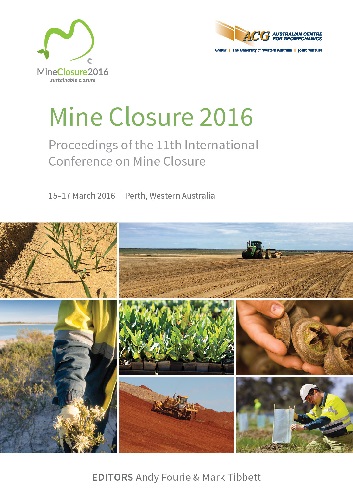Centrifuge modelling of drawdown seepage in tailings storage facilities

|
Authors: Beckett, CTS; Fourie, AB |
DOI https://doi.org/10.36487/ACG_rep/1608_19_Beckett
Cite As:
Beckett, CTS & Fourie, AB 2016, 'Centrifuge modelling of drawdown seepage in tailings storage facilities', in AB Fourie & M Tibbett (eds), Mine Closure 2016: Proceedings of the 11th International Conference on Mine Closure, Australian Centre for Geomechanics, Perth, pp. 277-290, https://doi.org/10.36487/ACG_rep/1608_19_Beckett
Abstract:
Uncertainties surrounding seepage behaviour are a key issue raised in tailings storage facility (TSF) operation. Poor seepage management can result in negative environmental impacts, costly remediation or even embankment failure and, in the context of mine closure, long term liabilities and/or legacy site issues. In particular, recovery pumping rates must be maintained for sufficient time to capture seepage both during operation and after closure during reservoir drawdown. Seepage analyses for TSF design commonly assume isotropic or, at best, anisotropic homogeneous material properties. However, layering during deposition, consolidation and swelling on drying and wetting create a seepage environment far more complex than these assumptions suggest. Improved modelling is required to increase analysis confidence. Centrifuge modelling allows geotechnical phenomena to be investigated using scale models under representative stress conditions. However, precious few examples exist for seepage modelling using this technique. This paper briefly discusses modelling equipment development for use with The University of Western Australia (UWA) beam geotechnical centrifuge. Results for seepage during reservoir drawdown, simulating facility closure, are then presented for a layered, heterogeneous embankment model, as compared to predictions made by commercial analysis software. Findings are used to comment on the implication of simplifying analysis assumptions on drawdown time and flowrate calculations.
Keywords: centrifuge modelling; tailings; seepage; drawdown
References:
Amoah, N, Phillips, J & Vlahos, S 2006, ‘Investigation of hydrological behaviour of in situ bauxite residue for closure and rehabilitation design’, in AB Fourie & M Tibbett (eds), Proceedings of the First International Seminar on Mine Closure, Australian Centre for Geomechanics, Perth, pp. 441–451.
Beckett, CTS, Fourie, AB & O’Loughlin, CD 2015, ‘Centrifuge modelling of seepage through tailings embankments’, International Journal of Physical Modelling in Geotechnics, in press, .
Chang, N, Heymann, G & Clayton, C 2011, ‘The effect of fabric on the behaviour of gold tailings’, Géotechnique 61(3), pp. 187–197.
Chapuis, RP 2012, ‘Predicting the saturated hydraulic conductivity of soils: a review’, Bulletin of Engineering Geology and the Environment, 71, pp. 401–434.
Kayabali, K & Ozdemir, A 2012, ‘Assessing the practicality of the centrifuge method for 1-D consolidation’, Bulletin of Engineering Geology and the Environment, 71, pp. 735–745.
Madabhushi, G 2014, Centrifuge modelling for civil engineers, CRC Press, London.
Reid, D, Fourie, A, Watson, S, Jewell, R 2012, ‘Accelerated consolidation testing of slurries using a desktop centrifuge’, in A Fourie & A Paterson (eds), Proceedings of the 15th International Seminar on Paste and Thickened Tailings (PASTE 2012), Australian Centre for Geomechanics, pp. 43–52.
Resnick, GS & Znidarčić, D 1990, ‘Centrifugal modeling of drains for slope stabilization’, Journal of Geotechnical Engineering, 116, pp. 1607–1624.
Sutherland, H & Rechard, R 1984, ‘Centrifuge simulations of stable tailings dam’, Journal of Geotechnical Engineering, American Society of Civil Engineers, 110, pp. 390–402.
Williams, D & Jones, H 2005, ‘Tailings storage facilities. In Advances in Gold Ore Processing’, in BA Wills (ed), Developments in Mineral Processing, vol. 15, Elsevier, Amsterdam, pp. 729–752.
Zhang, Q, Yin, G, Wei, Z, Fan, X, Wang, W & Nie, W 2015, ‘An experimental study of the mechanical features of layered structures in dam tailings from macroscopic and microscopic points of view’, Engineering Geology, 195, pp. 142–154.
© Copyright 2025, Australian Centre for Geomechanics (ACG), The University of Western Australia. All rights reserved.
View copyright/legal information
Please direct any queries or error reports to repository-acg@uwa.edu.au
View copyright/legal information
Please direct any queries or error reports to repository-acg@uwa.edu.au